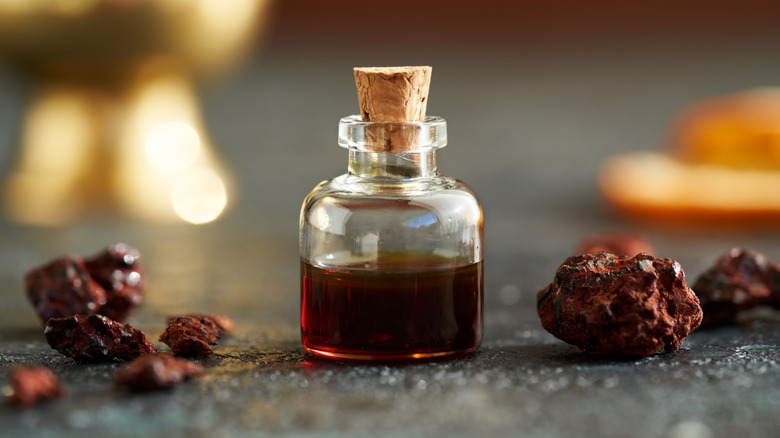What Is Dragon's Blood? The Skincare Ingredient Isn't As Scary As It Sounds
When it comes to beauty products, people will go to great lengths for perfect skin and hair. Infant foreskins for cell regeneration? Sure thing. Whale vomit as a fragrance? Yes, please. Bird droppings for wrinkle-free skin? Heck yeah. And that doesn't even include the human waste you just might find in some high-end beauty products. With these ingredients out there touting perfect skin, naturally, something called dragon's blood isn't going to cause any major pearl-clutching. If anything, its name alone is going to have people signing up for it.
"It's an indigenous tree from Mexico and Ecuador called the dragon tree," skin and hair care specialist Lucy Vincent Marr told Well + Good. "The resin looks like blood — it's a black-red sap, and it has incredible benefits for the tree ... Its intense healing properties work as a defense for the tree against pathogens, viruses, diseases, and pests. So that's why people started to look at what it can do for humans."
If you're thinking it's time to add a new product to your skincare routine or you have yet to find a product that works for you, dragon's blood could be just the thing you need. While in product form it may not be the brilliant red color like it is in nature — which is a bit disappointing — it can still have a positive impact on your skin.
Benefits of dragon's blood
There are more than a few benefits that dragon's blood has to offer. A 2015 study published in the Journal of Traditional and Complementary Medicine found that it has extensive healing and anti-inflammatory properties, making it effective on things like burns, bedsores, and even diabetic ulcers. Another study from 2008 published in the Journal of Ethnopharmacology found that dragon's blood is an antioxidant, as well as both antimicrobial and antiviral. All of these attributes make it a great asset when it comes to skincare.
"[Dragon's blood can help] stimulate the creation and migration of fibroblasts, a type of cell that contributes to the formation of connective tissue, and the production of collagen, resulting in skin regeneration and wound healing," dermatologist Dr. Jodi LoGerfo, DNP, APRN, FNP-BC told TZR. Cell rebuilding and wound healing are two very important components of healthy skin. Not just in how it looks, but in how it functions as a whole. Keeping the body's largest and most important organ in tip-top shape is essential for every other organ to maintain its integrity and perform necessary bodily tasks.
Who can use dragon's blood
Like any skincare product, dragon's blood isn't going to be for everyone. For example, people with ultra-sensitive skin and those who have a latex allergy should steer clear. "Dragon's blood is generally known to be suitable for all skin types, but those with latex allergies may also be allergic to dragon's blood as they are derived from similar trees," dermatologist Dr. Dendy Engelman, MD told IPSY. "As with any new ingredient, consult your dermatologist to see if it may be right for you."
If you don't have any allergy concerns and your dermatologist gives you the go-ahead to start using dragon's blood, you can begin looking into products that contain it — and there are many. "Since it is used so broadly, look for products that address your specific skin type and concerns," said Dr. Engelman. "For example, if you have dry skin, you may want to seek out a moisturizer or hydrating serum that contains dragon's blood." When you do add it to your skincare routine, give it a few weeks for the benefits to show their true colors. Rome wasn't built in a day, after all, so give the dragon's blood time to work its magic.


